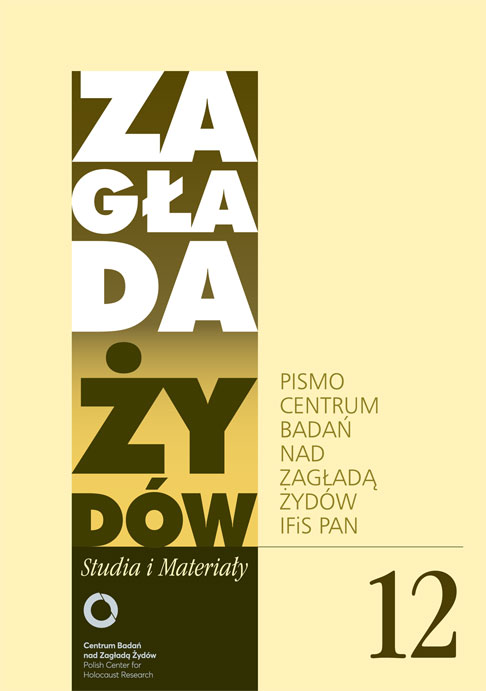Zagłada jako horror. Kilka uwag o literaturze polskiej 1985–2015
Zagłada Żydów. Studia i Materiały, Nr 12 (2016), Strony: 375-394
Data zgłoszenia: 2020-10-20Data publikacji: 2016-11-30
 https://doi.org/10.32927/ZZSiM.423
https://doi.org/10.32927/ZZSiM.423
Abstrakt
The author suggests that the depictions of the Holocaust in Polish literature of 1918–2014 should be categorized as horror. From the chronological perspective, Czapliński divides those thirty years into three shorter periods: 1) the initial period (from Claude Lanzmann’s Shoah and Jan Błoński’s essay “The Poor Poles Look at the Ghetto” to Wilhelm Dichter’s and Michał Głowiński’s memoirs) was dominated by white horror, which presented Jews as ghosts demanding a place in the Polish memory; 2) during the second period (from Marek Bieńczyk’s Tworki and Jan Tomasz Gross’ Neighbors until the end of the 2010s) the horror poetics was used to reveal those principles of pre-war and occupation-period normality which helped the Germans conduct the Holocaust and which conditioned the exclusion of Jews from the Polish circle of ‘normal humanity’; 3) during the third period (from Gross’s Golden Harvest until now) Jews return as the undead, violating the rules of distance and obliging Poles to physically touch the disgusting topic of the Holocaust. The contact with the Holocaust as something abhorring becomes a condition for self-knowledge, purging, and establishment of a new imaginary community.
Słowa kluczowe
Zagłada , horror , groza , obrzydliwość
Licencja
Prawa autorskie (c) 2016 Autor&"Zagłada Żydów. Studia i Materiały"

Utwór dostępny jest na licencji Creative Commons Uznanie autorstwa 4.0 Międzynarodowe.
https://creativecommons.org/licenses/by/4.0
Czasopismo publikowane jest w standardzie Diamond Open Access na licencji CC-BY-4.0 Deed - Uznanie autorstwa 4.0 Międzynarodowa - Creative Commons
Inne teksty tego samego autora
- Przemysław Czapliński, The Auschwitz Virus , Zagłada Żydów. Studia i Materiały: Nr Holocaust Studies and Materials (2017)
- Przemysław Czapliński, Prawda i co dalej , Zagłada Żydów. Studia i Materiały: Nr 15 (2019)
- Przemysław Czapliński, Wirus Auschwitz , Zagłada Żydów. Studia i Materiały: Nr 10 (2014)
Podobne artykuły
- Magdalena Bogusławska, Zagłada Żydów w serbskim porządku pamięci , Zagłada Żydów. Studia i Materiały: Nr 12 (2016)
- Dariusz Libionka, David Silberklang, Gates of Tears: The Holocaust in the Lublin District , Zagłada Żydów. Studia i Materiały: Nr 11 (2015)
- Carson Phillips, Szanse, wyzwania i interpretacje: nauczanie o Holokauście w Kanadzie , Zagłada Żydów. Studia i Materiały: Nr 11 (2015)
- Jan Grabowski, Redakcja, From the editor , Zagłada Żydów. Studia i Materiały: 2008: Holocaust Studies and Materials
- Dariusz Libionka, Głową w mur. Interwencje Kazimierza Papée, polskiego ambasadora przy Stolicy Apostolskiej, w sprawie zbrodni niemieckich w Polsce, listopad 1942 – styczeń 1943 , Zagłada Żydów. Studia i Materiały: Nr 2 (2006)
- Kinga Piotrkowiak-Junkiert, Stan badań nad Zagładą na Węgrzech , Zagłada Żydów. Studia i Materiały: Nr 12 (2016)
- Piotr Litka, Zdzisław Lorek, Grzegorz Pawlikowski, Śledztwo sędziego Władysława Bednarza w sprawie niemieckiego obozu zagłady Kulmhof , Zagłada Żydów. Studia i Materiały: Nr 14 (2018)
- Marta Tomczok, Kinga Piotrowiak-Junkiert, Świadomość zwrócona przeciwko sobie samej. Imre Kertész wobec Zagłady , Zagłada Żydów. Studia i Materiały: Nr 12 (2016)
- Klaus Peter Friedrich, Nazistowski mord na Żydach w prasie polskich komunistów (1942–1944). , Zagłada Żydów. Studia i Materiały: Nr 2 (2006)
- Marta Tomczok, Demon pojednania. Dyskurs o współczesnych Sprawiedliwych w powieści popularnej , Zagłada Żydów. Studia i Materiały: Nr 12 (2016)
<< < 1 2 3 4 5 6 7 8 9 10 11 12 13 14 15 16 17 18 19 20 21 22 23 24 25 26 27 28 29 30 31 32 33 34 35 36 37 38 39 40 41 42 43 44 > >>
Możesz również Rozpocznij zaawansowane wyszukiwanie podobieństw dla tego artykułu.
 English
English
 Język Polski
Język Polski



 https://orcid.org/0000-0002-4805-6471
https://orcid.org/0000-0002-4805-6471





